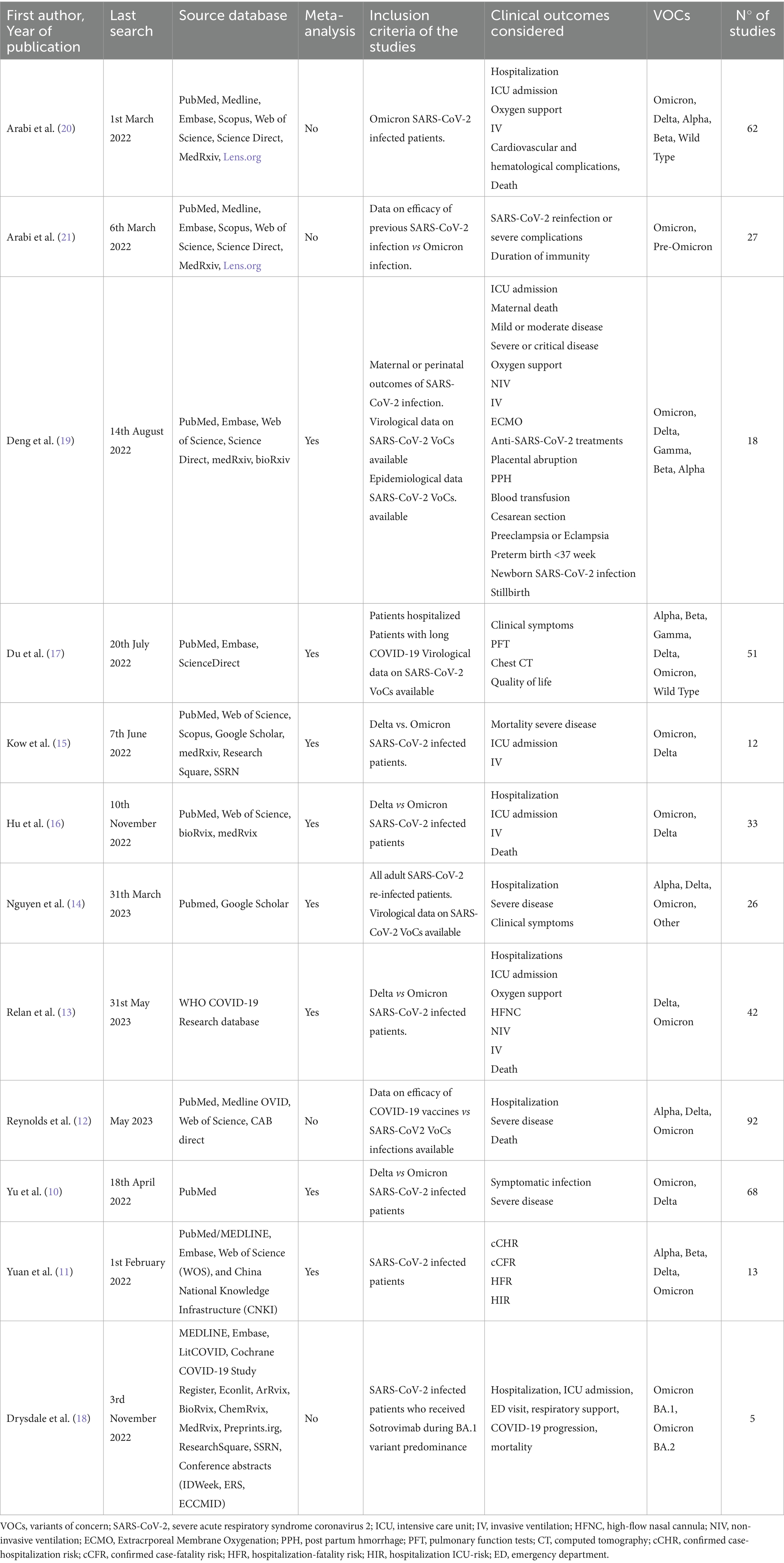- 1Department of Infectious Diseases, Luigi Sacco University Hospital, Milan, Italy
- 2Centre for Multidisciplinary Research in Health Science (MACH), University of Milan, Milan, Italy
- 3Infectious Diseases Unit, Fondazione IRCCS Ca' Granda Ospedale Maggiore Policlinico, Milan, Italy
- 4Evidence-Based Practice Center, Mayo Clinic, Rochester, MN, United States
- 5Department of Pathophysiology and Transplantation, University of Milan, Milan, Italy
- 6Department of Biomedical and Clinical Sciences, University of Milan, Milan, Italy
Background: Synthesizing data from existing literature is crucial for validating the robustness of associations, assessing data quality, and forming recommendations, especially given the vast amount of information available on SARS-CoV-2. This study aims to conduct an overview of reviews to evaluate the strength and validity of associations between VOCs and specific clinical outcomes in COVID-19 patients.
Methods: An overview of reviews according to the principles of PRIOR protocol was performed searching multiple databases in January 2024 and an updated search was conducted in MEDLINE database in June 2025. Peer reviewed systematic reviews considering two or more VOCs and reporting on clinical outcomes such as mortality, hospitalization, severe disease, admission to ICU, and mechanical ventilation were included. Data on study population and measures of association between clinical outcome and VOCs were considered. The quality of the studies was assessed through the AMSTAR-2 tool. Effect sizes and confidence intervals for each association between VOCs and clinical outcomes were reported. Subgroup analyses were performed where feasible. A citation matrix was used to assess the overlap between the included systematic reviews.
Results: Twelve studies were included in the review, with a total of 24 comparisons, primarily between Omicron and Delta variants (19/24). Omicron was consistently associated with better clinical outcomes compared to Delta. The confidence in the results of 10/12 studies was rated critically low. The overlap between the included reviews was minimal, with 10% having significant overlap (>15%).
Conclusion: Our overview of reviews shows the lower hazard on human health of the Omicron compared to Delta variant. However, the quality of the reviews included was generally low, prompting the need for more rigorous systematic reviews.
Systematic review registration: This overview of reviews was registered in PROSPERO, CRD42024500841; https://www.crd.york.ac.uk/PROSPERO/display_record.php?ID=CRD42024500841.
Background
The severe acute respiratory syndrome coronavirus 2 (SARS-CoV-2) pandemic represents one of the deadliest outbreaks of this century, causing an unprecedented global health crisis. Since its emergence in December 2019, the novel virus has caused approximately 778 million cases and at least 7.1 million deaths (1).
Following the first viral strain detected in Wuhan in 2019, multiple mutations have led to the emergence of variants of concern (VOCs) that circulated all over the world, changing the trajectory of the pandemic in terms of infections rates, severity of disease and death (2). Since then, the variants of concern have remained within the Omicron lineage, with JN.1 and KS.1 currently being the most relevant sublineages. These Omicron subvariants continue to drive new waves of infection, and their identification and tracking remain central to ongoing surveillance efforts, as highlighted by recent molecular and epidemiological studies (3, 4). On the other hand, earlier VOCs—Alpha, Beta, Gamma, and Delta—are no longer in significant circulation (3, 5). Together with the development and distribution of COVID-19 (coronavirus disease 2019) vaccines, a pivotal moment was the emergence of the Delta variant (B.1.617.2) noted for its high transmissibility and greater virulence than its predecessors. This VOC prevailed over other variants from late 2020 to early 2021 causing a significant spike in COVID-19 mortality. Another turning point was the subsequent emergence of the Omicron (B.1.1.529) and its subvariants, which are much more transmissible but less virulent than Delta (6).
Given the substantial and heterogeneous amount of evidence for clinical outcome associated with different VOCs, it is critical to understand how these variants impact COVID-19 clinical outcomes. This study aims to analyze systematic reviews, through an overview of reviews, that report on COVID-19 clinical outcomes stratified by VOCs.
Methods
Data sources and search strategy
A comprehensive literature search across several databases was conducted on January 18, 2024, with no language restrictions. The databases searched included Ovid MEDLINE 1946 to Present and Epub Ahead of Print, Ovid Embase (1974+), Web of Science Core Collection via Clarivate Analytics (1975+), and Scopus via Elsevier (1788+). Animal studies were excluded. The date limits were set between December 2022 and January 2024; an updated search was conducted in the MEDLINE database on June 10, 2025. The search strings were designed with a medical librarian with inputs from the study investigators. Controlled vocabulary terms were supplemented with keywords. The search strategy is available in the Supplementary File S1.
Systematic review selection and data extraction
An overview of reviews was conducted using multiple databases in January 2024, in accordance with the principles and definitions to Preferred Reporting Items for Overviews of Reviews (PRIOR); the protocol was prospectively registered with the PROSPERO database (CRD42024500841) (7).
The following inclusion criteria were applied: (i) peer-reviewed systematic reviews with or without meta-analysis, (ii) with data on at least two VOCs, and (iii) with one clinical outcome of interest associated with one or more VOCs. Clinical outcomes under evaluation included: mortality, hospitalization, intensive care unit (ICU) admission, invasive ventilation, and severe disease. Exclusion criteria were: (i) systematic reviews focusing on infants and subjects under 18 years of age, (ii) systematic reviews with insufficient details to extract data on the total number of patients included, (iii) systematic reviews without an effect size of association between the clinical outcome and the VOCs, and (iv) narrative reviews or reviews conducted without systematic methodology. Although we initially intended to investigate any clinical outcome, we subsequently decided to focus solely on key outcomes; this decision distinguishes this overview of reviews from the original PROSPERO protocol.
Citations were managed using a systematic review software (Covidence), and duplicates were removed. All titles and abstracts were independently screened by at least two of the three reviewers (FB, RF, and PR), followed by a full-text review of the selected articles conducted by the same reviewers. Discrepancies were resolved through discussion with a fourth reviewer (FF). Data extraction was performed independently by at least two reviewers out of four (FB, FF, RF, and PR) with discrepancies resolved with another reviewer (MP). The following data were collected: (i) systematic reviews’ information: year of publication, source databases, and last date of literature search, (ii) included studies and patients’ information: inclusion criteria, number of studies included, number of patients included, (iii) outcomes’ information: VOCs considered, clinical outcomes considered, adjustments done, subgroup analyses, and effect estimates odds ratio (OR), risk ratio (RR) and hazard ratio (HR) with 95% confidence intervals (CIs).
Confidence in the results assessment
The quality of included systematic reviews was assessed using the A MeaSurement Tool to Assess systematic Reviews 2 (AMSTAR-2). This tool consists of 16 items presented as questions, seven of which are considered critical. The overall confidence in the results of the reviews is rated as follows: (i) high, no or one non-critical weakness; (ii) moderate, more than one non-critical weakness; (iii) low, one critical flaw with or without non-critical weakness; (iv) critically low, more than one critical flaw with or without non-critical weakness (8). The AMSTAR-2 was filed independently by two of four authors (FB, RF, PR, and FF) and discrepancies resolved through discussion with another reviewer (MP).
Data analysis
We reported effect size measures with the corresponding 95% CI for each association between VOCs and the clinical outcome of interest. For the studies that directly compared two or more VOCs, the effect size measures considered included HR, OR and RR. We also planned to report the effect size measures for any subgroups analyzed within the studies.
A citation matrix visually organizing systematic reviews was constructed to assess their overlap using the Graphical Representation of Overlap for OVErviews (GROOVE) tool. This matrix quantifies overlap through the Corrected Covered Area (CCA), which is classified as very high (>15%), high (11–15%), moderate (6–10%), or slight (0–5%). The CCA is a validated method for measuring overlap between reviews, aiding in decision-making on managing overlap (9).
Results
We identified 3,547 articles: 1,253 from Scopus, 1,011 from Embase, 961 form PubMed and 322 from Web of Science. After deduplication, 1,940 articles underwent title and abstract screening resulting in 164 studies selected for full-text review. The entire screening process ultimately included 12 articles in the final review (Figure 1) (10–21).
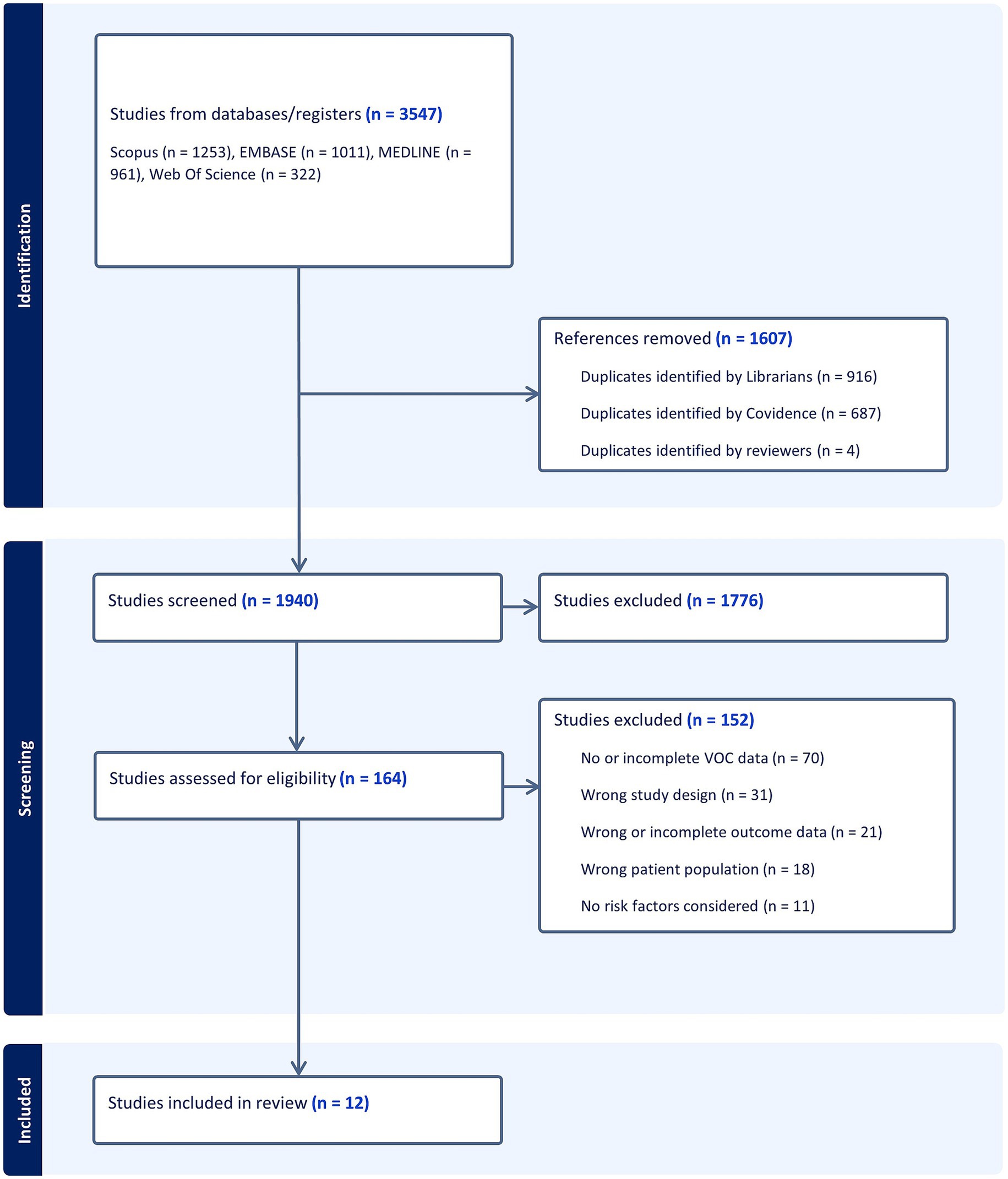
Figure 1. Flow-chart, adapted from PRISMA. Illustration of screening process of systematic reviews, from initial selection to the final studies included for data extraction.
Characteristic of included studies
The characteristics of the selected systematic reviews are summarized in Table 1. Among the 12 studies included, the majority used data published prior to 2023 (8/12, ~ 67%), and conducted a meta-analysis (9/12, ~ 75%). The number of total primary studies included in each systematic reviews ranged from 5 to 92. The VOCs examined were predominantly Omicron (12/12) and Delta (11/12). Four reviews focused exclusively on Omicron and Delta infections, one systematic review compared Omicron with all previous VOCs combined as one single group and one systematic review compared two different Omicron subvariants (BA1 and BA2). The study populations ranged from 8,850 to 670,913,033.
Clinical outcomes
Three studies compared mortality between Omicron and Delta in the overall population, and all of them reported a statistically significant lower odds or risk of mortality for patients infected with Omicron (Table 2), specifically RR 0.39 CI 95% 0.33–0.46, OR 0.33 CI 95% 0.16–0.67 (15) (4) and OR 0.34 CI 95% 0.25–0.46 (5, 6) (13, 15, 16). These results were also confirmed by the single systematic review adjusting for vaccination status (6), and by the subgroup analysis focusing on hospitalized patients and pregnant women (5, 7) (13, 16, 19). Only one review assessed the OR of mortality between Delta and pre-Delta in pregnant women, reporting lower odds in the pre-Delta era (7) (Table 2) (19). Omicron was statistically associated with lower odds and risk of ICU admission and invasive ventilation compared to Delta in the overall population and in the analyses considered, including analysis restricted to hospitalized patients and pregnant women (Table 3).
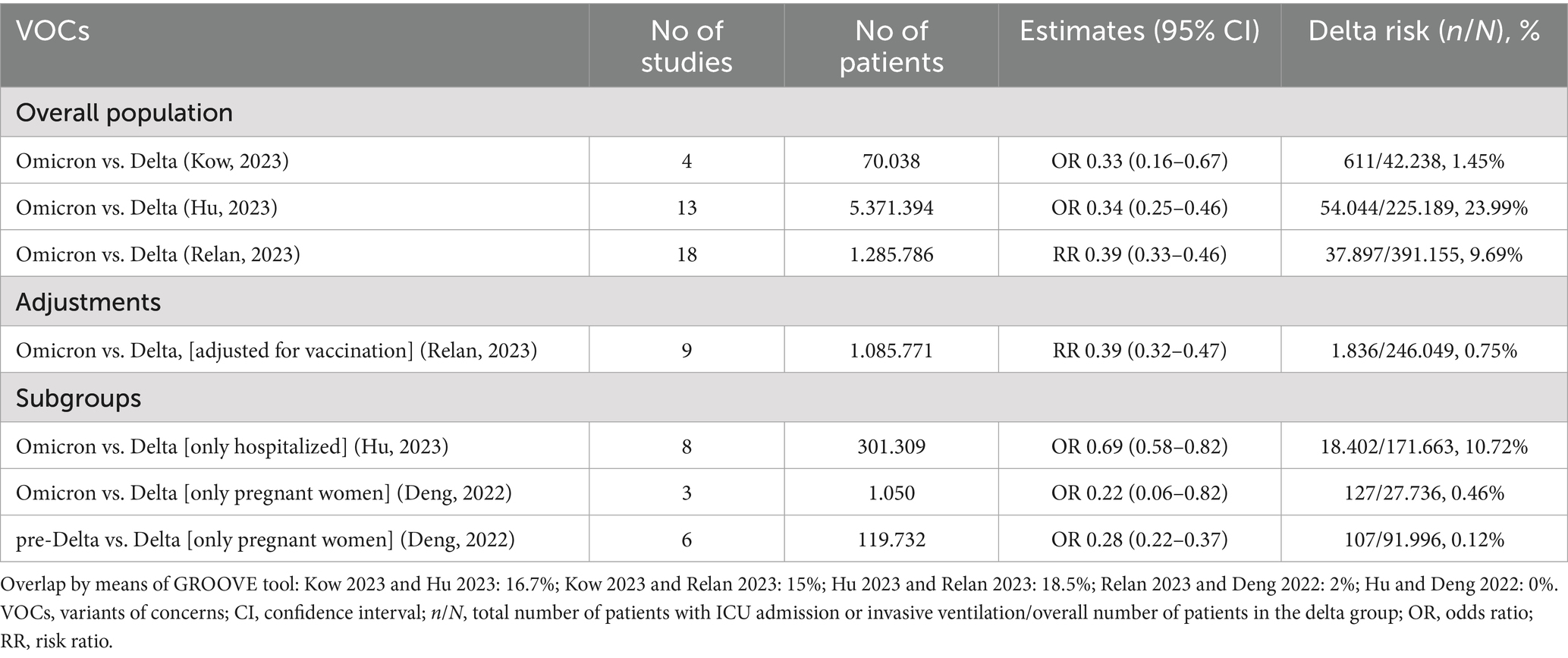
Table 2. Estimates of mortality associated with different VOCs, including effect sizes and mortality estimates, extracted from the selected systematic reviews.
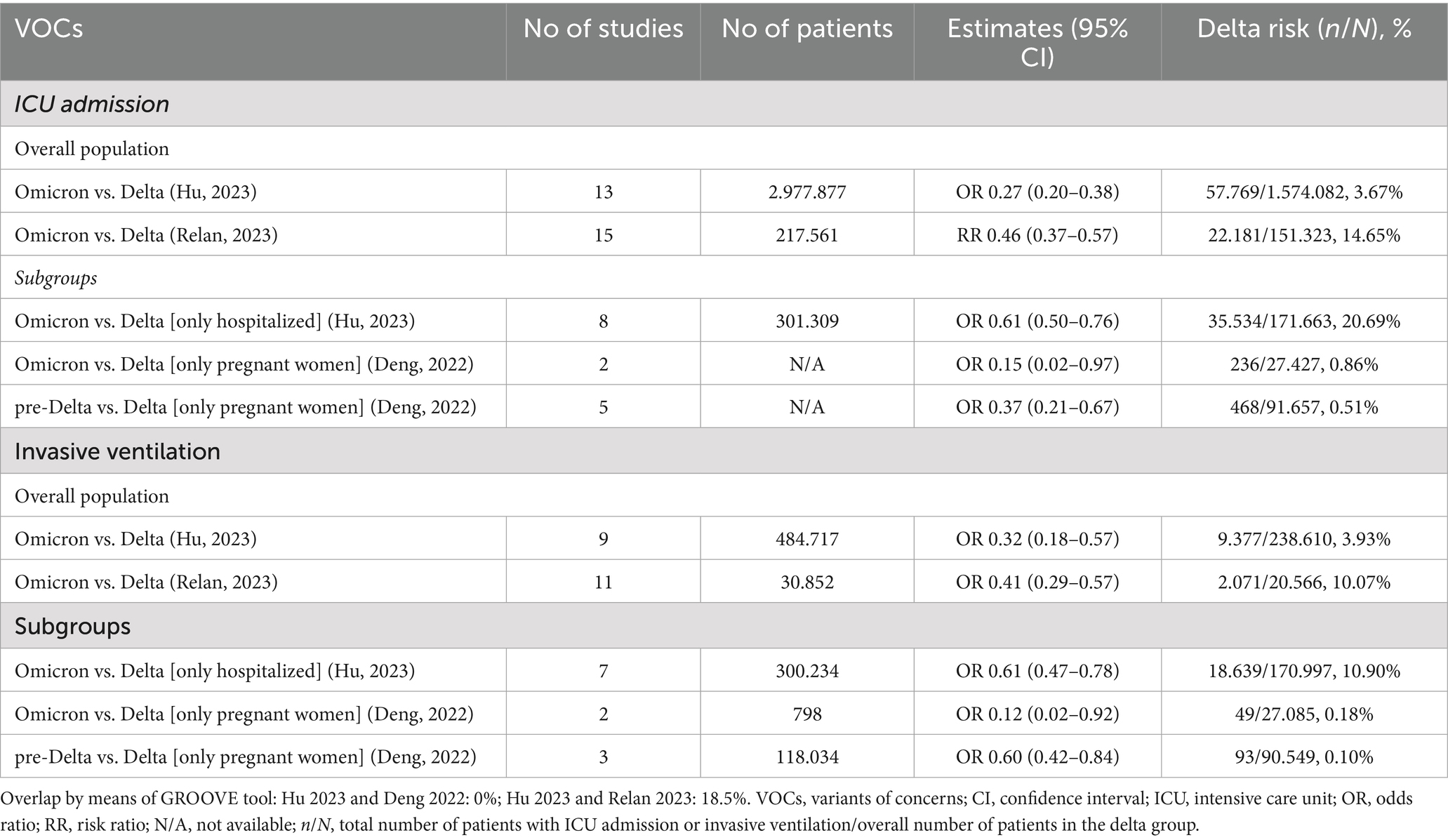
Table 3. Estimates of ICU admission associated with different VOCs, including effect sizes and mortality estimates, extracted from the selected systematic reviews.
Regarding hospitalization, Omicron was associated with lower odds compared to Delta. Two different reviews assessed the difference between Omicron BA1 and BA2 in the estimates of hospitalization, one adjusting for vaccination and the other for the prescription of Sotrovimab, and neither found significant differences (Supplementary Table S1) (13, 18).
However, it should be noted that in the latter review, only 5 papers were included and only one of them considered the difference in hospitalization between BA.1 and BA.2 (18).
As for severe disease, patients infected with Omicron were also less likely to develop it compared to those infected with Delta (Supplementary Table S2).
Confidence in the results
The overall confidence in the results was rated as high in only one systematic review (5) (16). Two were rated low (7, XX), and all the remaining results were rated critically low (4, 6, 7, 9–14). Regarding the critical items, only 3/12 studies reported clearly that the review methods were established prior to the conduct of the review (item 2); 11/12 had an adequate search strategy (item 4); 7/12 did not provide details or justifications for the excluded studies (item 7); 8/12 did not use or report satisfactory techniques to assess the risk of bias of the included studies (item 9); 5/12 did not consider this in their presentation of results (item 13). Only one out of eight systematic reviews that performed a meta-analysis explicitly stated in the protocol the principles guiding the decision to execute it (item 11), and only five of them considered the risk of publication bias in their results (item 15). The scores of individual studies are summarized in Table 4.
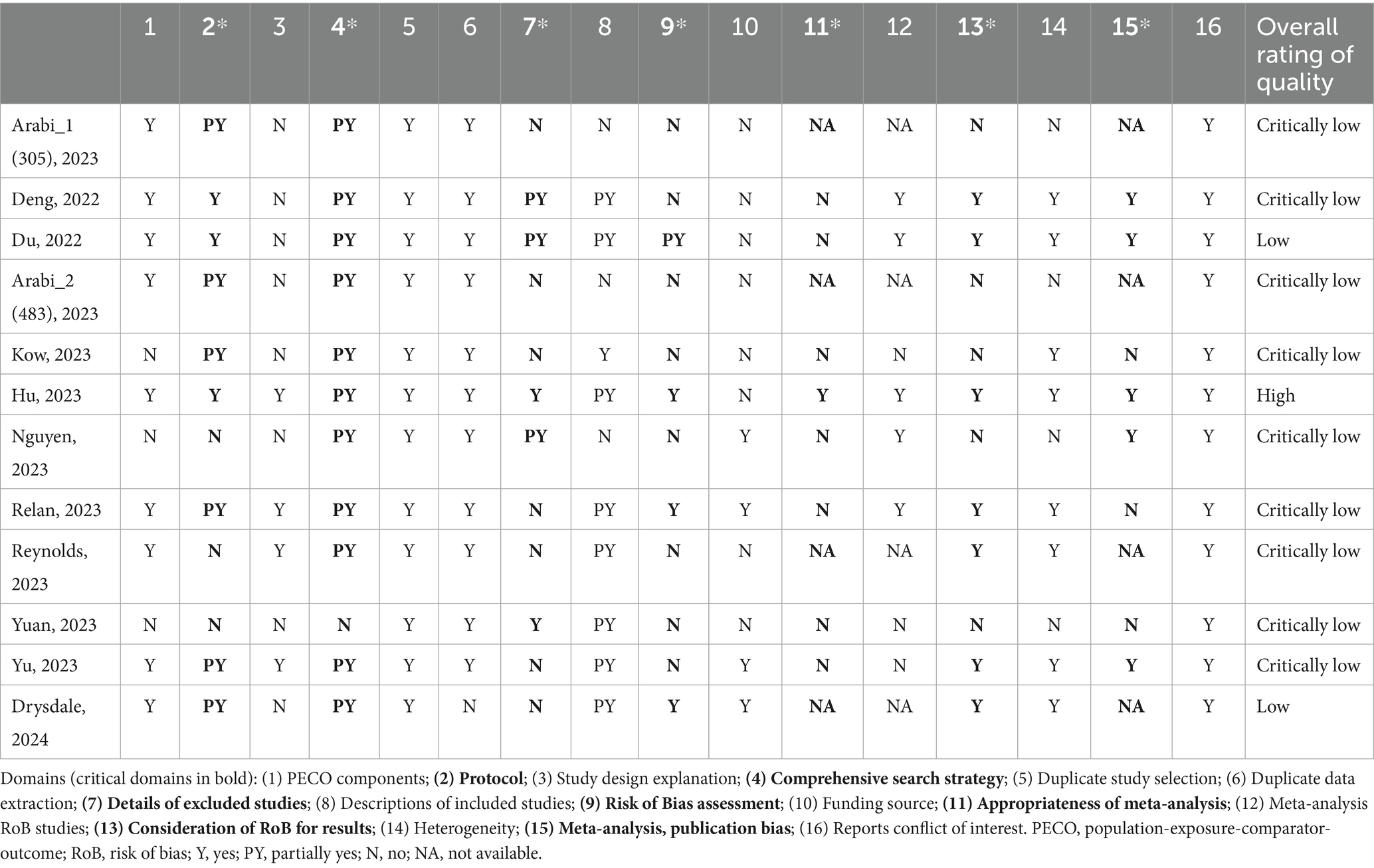
Table 4. Assessment of methodological quality and confidence in the results of the included systematic reviews using the AMSTAR-2 tool (critical domains in bold).
Overlap analysis
Overall, the overlap between the included reviews was generally low, with 51 out of 66 combinations showing slight overlap (<5%) (Supplementary Figure S1).
Discussion
Our systematic review shows that individuals infected with the SARS-CoV-2 Omicron variant experience a lower risk of adverse clinical outcomes compared to those infected with the Delta variant. Additionally, the overall quality of systematic reviews comparing hospital outcomes across multiple variants was generally low, and there was relatively low overlap among the systematic reviews included in our analysis.
The widespread distribution of COVID-19 vaccines and the emergence of the less virulent SARS-CoV-2 Omicron variant have significantly altered the pandemic’s trajectory. A recent systematic review, which examined the case fatality rate (CFR) of various SARS-CoV-2 variants across different continents, confirmed that Omicron poses a lower hazard compared to other variants (22).
Additionally, the reduced severity of Omicron infections may be due to its emergence 2 years into the pandemic and 1 year after the vaccination campaign began, by which time many individuals had likely acquired natural and/or vaccine-induced immunity.
Despite Omicron’s lower mortality and other adverse outcomes compared to Delta, it remains a significant public health threat. Data indicate that Omicron’s hospitalization and mortality rates are comparable to, if not higher than, those of other endemic respiratory viruses such as influenza and respiratory syncytial virus (23, 24). Existing literature suggests that individual risk factors, such as male gender, age over 60 years, smoking, hypertension, diabetes, cancer, cerebrovascular disease, chronic kidney disease, chronic pulmonary disease, and chronic liver disease, may vary in their influence depending on VOCs, and their role on COVID-19 outcomes has been extensively studied (25).
Moreover, it is well-established that the number of comorbidities also impacts COVID-19 infection outcomes, though their influence may differ by VOCs. Specifically, a study by Piralla et al. found that ICU patients with Omicron were more likely to have three or more comorbidities compared to those with Delta, indicating that Delta infections are more aggressive and require fewer underlying conditions to become severe (26). Unfortunately, our review could not determine the differential impact of individual risk factors on clinical outcomes across VOCs.
Beyond the primary findings of our overview of reviews, one result we consider equally important yet troubling is the overall poor quality of the systematic reviews analyzed. From our perspective, systematic reviews with meta-analyses represent a powerful tool for scientific dissemination, and the rigor we expect is crucial for acquiring fundamental information. It is not surprising, though disappointing, that some of this rigor may have been compromised during the early stages of the COVID-19 pandemic. However, we believe that strictly adhering to scientifically rigorous checklists for proper systematic review methodology is a responsibility we, as researchers, owe to the common good—that is, the advancement of knowledge in our challenging scientific field. This goal should not be lost even in emergency settings like pandemics, where frameworks for evidence synthesis programs exist (27, 28). Our review identified several recurrent methodological flaws across the included studies, with some of the most relevant being the lack of information on excluded studies, insufficient risk of bias assessment, and limited consideration of bias in the interpretation of results—all of which are classified as critical domains in the AMSTAR-2 checklist. Future systematic reviews on this topic should aim to address these and other methodological weaknesses more rigorously, in order to acquire more reliable information in the future.
Some limitations must be considered. First, the focus on systematic reviews may have limited our findings by excluding individual studies. Second, most included reviews compared Omicron to Delta, while few addressed the various Omicron sublineages that currently dominate the COVID-19 landscape, and no comparisons with earlier variants were available in the selected papers. However, these findings reflect the scope and limitations of the existing literature at the time of our search, as well as the eligibility criteria applied in our review.
Third, omicron is markedly more transmissible and less virulent than previous VOCs, and underreporting remains a common issue.
Finally, our study could not assess the potential impact of other characteristics affecting clinical outcomes, such as vaccination status, type of treatment, and comorbidities; however, few of the included studies reported adjustments and subgroup analyses.
To our knowledge, this is the first overview of reviews to systematically synthesize evidence on COVID-19 clinical outcomes by variant, with particular attention to the methodological quality of the included systematic reviews.
Despite its limitations, we believe our work offers meaningful contributions, offering a valuable foundation for future research and informing public health strategies in the face of an evolving SARS-CoV-2 landscape.
Conclusion
Our overview of reviews highlights the lower health risk posed by the Omicron variant but also reveals a lack of high-quality systematic reviews regarding the role of comorbidities and other risk factors in COVID-19 progression. More research is needed to understand how different comorbidities influence severe COVID-19, and rigorous systematic reviews are essential to fill this gap and to aid in developing targeted clinical guidelines and public health policies.
Data availability statement
The original contributions presented in the study are included in the article/Supplementary material, further inquiries can be directed to the corresponding author.
Author contributions
FF: Data curation, Conceptualization, Writing – original draft, Writing – review & editing. RF: Writing – review & editing, Data curation. PR: Data curation, Writing – review & editing. FB: Data curation, Writing – review & editing. DH: Writing – review & editing. TM: Data curation, Writing – review & editing. TN: Methodology, Writing – review & editing. AB: Writing – review & editing. AG: Writing – review & editing. MP: Writing – review & editing, Conceptualization, Visualization, Formal analysis, Validation, Methodology. MC: Validation, Visualization, Formal analysis, Conceptualization, Writing – review & editing.
Funding
The author(s) declare that financial support was received for the research and/or publication of this article. This work was funded by the European Union under grant agreement no. 101046314 (END-VOC project).
Acknowledgments
We want to thank Flavia Rampichini and Elena Bernardini of the Library Service of Milan. University for their help in designing the research strings.
Conflict of interest
The authors declare that the research was conducted in the absence of any commercial or financial relationships that could be construed as a potential conflict of interest.
The author(s) declared that they were an editorial board member of Frontiers, at the time of submission. This had no impact on the peer review process and the final decision.
Generative AI statement
The authors declare that no Gen AI was used in the creation of this manuscript.
Publisher’s note
All claims expressed in this article are solely those of the authors and do not necessarily represent those of their affiliated organizations, or those of the publisher, the editors and the reviewers. Any product that may be evaluated in this article, or claim that may be made by its manufacturer, is not guaranteed or endorsed by the publisher.
Supplementary material
The Supplementary material for this article can be found online at: https://www.frontiersin.org/articles/10.3389/fmed.2025.1624459/full#supplementary-material
Abbreviations
SARS-CoV-2, severe acute respiratory syndrome coronavirus 2; COVID-19, coronavirus disease 19; VOCs, variants of concern; PRIOR, preferred reporting items for overviews of reviews; ICU, intensive care unit; AMSTAR-2, A MeaSurement Tool to Assess systematic Reviews-2; CI, confidence interval; GROOVE, Graphical Representation of Overlap for OVErviews; OR, odds ratio; RR, risk ratio; HR, hazard ratio; CCA, corrected covered area; CFR, case fatality rate.
References
1. COVID-19 Deaths | WHO COVID-19 Dashboard. (2024). Available online at: https://data.who.int/dashboards/covid19/deaths?n=o. [Accessed 16 June, 2025].
2. Wu, F, Zhao, S, Yu, B, Chen, Y.-M., and Wang, W. Genomic characterisation and epidemiology of 2019 novel coronavirus: implications for virus origins and receptor binding. The Lancet. (2020) 395:565–74. doi: 10.1016/S0140-6736(20)30251-8
3. Alhamlan, FS, and Al-Qahtani, AA. SARS-CoV-2 variants: genetic insights, epidemiological tracking, and implications for vaccine strategies. Int J Mol Sci. (2025) 26:1263. doi: 10.3390/ijms26031263
4. Makarova, VO, Shelkov, A, Iliukhina, A, Azizyan, V, Dolzhikova, IV, Vasilieva, E, et al. Real-time PCR-based test as a research tool for the retrospective detection and identification of SARS-CoV-2 variants of concern in a sample. Int J Mol Sci. (2025) 26:1786. doi: 10.3390/ijms26051786
5. Liu, B, Wang, Z, Lu, S, Qi, Z, Zhang, Z, Luan, J, et al. Monitoring reported SARS-CoV-2 variants to assess the status of COVID-19 epidemics in the low epidemic state. Sci Rep. (2025) 15:10169. doi: 10.1038/s41598-025-91308-1
6. CoVariants [Internet]. (2025). Available online at: https://covariants.org/ (Accessed June 16, 2025).
7. Gates, M, Gates, A, Pieper, D, Fernandes, RM, Tricco, AC, and Moher, D. Reporting guideline for overviews of reviews of healthcare interventions: development of the PRIOR statement. BMJ. (2022) 378:e070849. doi: 10.1136/bmj-2022-070849
8. Shea, BJ, Reeves, BC, Wells, G, Thuku, M, Hamel, C, and Moran, J. AMSTAR 2: a critical appraisal tool for systematic reviews that include randomised or non-randomised studies of healthcare interventions, or both. BMJ. (2017) 358:j4008. doi: 10.1136/bmj.j4008
9. Pérez-Bracchiglione, J, Meza, N, Bangdiwala, SI, Niño de Guzmán, E, Urrútia, G, and Bonfill, X. Graphical representation of overlap for OVErviews: GROOVE tool. Res Synth Methods. (2022) 13:381–8. doi: 10.1002/jrsm.1557
10. Yu, W, Guo, Y, Zhang, S, Kong, Y, Shen, Z, and Zhang, J. Proportion of asymptomatic infection and nonsevere disease caused by SARS-CoV-2 omicron variant: a systematic review and analysis. J Med Virol. (2022) 94:5790–801. doi: 10.1002/jmv.28066
11. Yuan, Z, Shao, Z, Ma, L, and Guo, R. Clinical severity of SARS-CoV-2 variants during COVID-19 vaccination: a systematic review and Meta-analysis. Viruses. (2023) 15:1994. doi: 10.3390/v15101994
12. Reynolds, L, Dewey, C, Asfour, G, and Little, M. Vaccine efficacy against SARS-CoV-2 for Pfizer bio NTech, Moderna, and Astra Zeneca vaccines: a systematic review. Front Public Health. (2023) 11:1229716. doi: 10.3389/fpubh.2023.1229716
13. Relan, P, Motaze, NV, Kothari, K, Askie, L, Le Polain, O, and Van Kerkhove, MD. Severity and outcomes of omicron variant of SARS-CoV-2 compared to Delta variant and severity of omicron sublineages: a systematic review and metanalysis. BMJ Glob Health. (2023) 8:e012328. doi: 10.1136/bmjgh-2023-012328
14. Nguyen, NN, Nguyen, YN, Hoang, VT, Million, M, and Gautret, P. SARS-CoV-2 reinfection and severity of the disease: a systematic review and Meta-analysis. Viruses. (2023) 15:967. doi: 10.3390/v15040967
15. Kow, CS, Ramachandram, DS, and Hasan, SS. The risk of mortality and severe illness in patients infected with the omicron variant relative to delta variant of SARS-CoV-2: a systematic review and meta-analysis. Ir J Med Sci. (2023) 192:2897–904. doi: 10.1007/s11845-022-03266-6
16. Hu, FH, Jia, YJ, Zhao, DY, Fu, XL, Zhang, WQ, and Tang, W. Clinical outcomes of the severe acute respiratory syndrome coronavirus 2 omicron and Delta variant: systematic review and meta-analysis of 33 studies covering 6 037 144 coronavirus disease 2019–positive patients. Clin Microbiol Infect. (2023) 29:835–44. doi: 10.1016/j.cmi.2023.03.017
17. Du, M, Ma, Y, Deng, J, Liu, M, and Liu, J. Comparison of long COVID-19 caused by different SARS-CoV-2 strains: a systematic review and Meta-analysis. Int J Env Res Public Health. (2022) 19:16010. doi: 10.3390/ijerph192316010
18. Drysdale, M, Gibbons, DC, Singh, M, Rolland, C, Lavoie, L, and Skingsley, A. Real-world effectiveness of sotrovimab for the treatment of SARS-CoV-2 infection during omicron BA.2 subvariant predominance: a systematic literature review. Infection. (2024) 52:1–17. doi: 10.1007/s15010-023-02098-5
19. Deng, J, Ma, Y, Liu, Q, Du, M, Liu, M, and Liu, J. Association of Infection with different SARS-CoV-2 variants during pregnancy with maternal and perinatal outcomes: a systematic review and Meta-analysis. Int J Env Res Public Health. (2022) 19:15932. doi: 10.3390/ijerph192315932
20. Arabi, M, Al-Najjar, Y, Sharma, O, Kamal, I, Javed, A, and Gohil, HS. Role of previous infection with SARS-CoV-2 in protecting against omicron reinfections and severe complications of COVID-19 compared to pre-omicron variants: a systematic review. BMC Infect Dis. (2023) 23:1–16. doi: 10.1186/s12879-023-08328-3
21. Arabi, M, Al-Najjar, Y, Mhaimeed, N, Salameh, MA, Paul, P, and AlAnni, J. Severity of the omicron SARS-CoV-2 variant compared with the previous lineages: a systematic review. J Cell Mol Med. (2023) 27:1443–64. doi: 10.1111/jcmm.17747
22. Xia, Q, Yang, Y, Wang, F, Huang, Z, Qiu, W, and Mao, A. Case fatality rates of COVID-19 during epidemic periods of variants of concern: a meta-analysis by continents. Int J Infect Dis. (2024) 141:106950. doi: 10.1016/j.ijid.2024.01.017
23. Grant, R, de Kraker, MEA, Buetti, N, Jackson, H, Abbas, M, Sobel, JA, et al. In-hospital outcomes of healthcare-associated coronavirus disease 2019 (omicron) versus healthcare-associated influenza: a retrospective, Nationwide cohort study in Switzerland. Clin Infect Dis. (2024):558. doi: 10.1093/cid/ciae558
24. Nørgaard, SK, Nielsen, J, Nordholm, AC, Richter, L, Chalupka, A, Sierra, NB, et al. Excess mortality in Europe coincides with peaks of COVID-19, influenza and respiratory syncytial virus (RSV), November 2023 to February 2024. Eurosurveillance. (2024) 29:2400178. doi: 10.2807/1560-7917.ES.2024.29.15.2400178
25. Reyna-Villasmil, E, Caponcello, MG, Maldonado, N, Olivares, P, Caroccia, N, Bonazzetti, C, et al. Association of Patients’ epidemiological characteristics and comorbidities with severity and related mortality risk of SARS-CoV-2 infection: results of an umbrella systematic review and Meta-analysis. Biomed Ottobre. (2022) 10:2437. doi: 10.3390/biomedicines10102437
26. Piralla, A, Mojoli, F, Pellegrinelli, L, Ceriotti, F, Valzano, A, and Grasselli, G. Impact of SARS-CoV-2 omicron and Delta variants in patients requiring intensive care unit (ICU) admission for COVID-19, northern Italy, December 2021 to January 2022. Respir Med Res. (2023) 83:100990. doi: 10.1016/j.resmer.2023.100990
27. Hassan Murad, M, Nayfeh, T, Urtecho Suarez, M, Seisa, MO, Abd-Rabu, R, and Hassan Eltayeb Farah, M. A framework for evidence synthesis programs to respond to a pandemic. Mayo Clin Proc. (2020) 95:1426–9. doi: 10.1016/j.mayocp.2020.05.009
Keywords: SARS-CoV-2, Omicron, Delta, VOCs, systematic reviews, COVID-19
Citation: Fama F, Fattore R, Raimondo P, Brivio F, Holmes D, Muheberimana T, Nayfeh T, Bandera A, Gori A, Passerini M and Colaneri M (2025) The impact of SARS-CoV-2 VOCs on clinical outcomes: an overview of reviews. Front. Med. 12:1624459. doi: 10.3389/fmed.2025.1624459
Edited by:
Sanjeet Kumar, Illumina, Inc., IndiaReviewed by:
Kanika Bansal, Institute of Microbial Technology (CSIR), IndiaVivek P. Chavda, LM College of Pharmacy, India
Almir Ribeiro da Silva Jr., University of São Paulo, Brazil
Khin Phyu Pyar, Ministry of Health (Myanmar), Myanmar
Copyright © 2025 Fama, Fattore, Raimondo, Brivio, Holmes, Muheberimana, Nayfeh, Bandera, Gori, Passerini and Colaneri. This is an open-access article distributed under the terms of the Creative Commons Attribution License (CC BY). The use, distribution or reproduction in other forums is permitted, provided the original author(s) and the copyright owner(s) are credited and that the original publication in this journal is cited, in accordance with accepted academic practice. No use, distribution or reproduction is permitted which does not comply with these terms.
*Correspondence: Rebecca Fattore, cmViZWNjYS5mYXR0b3JlQHVuaW1pLml0
†These authors have contributed equally to this work
 Federico Fama
Federico Fama Rebecca Fattore
Rebecca Fattore Paolo Raimondo1
Paolo Raimondo1 Darcy Holmes
Darcy Holmes Toussaint Muheberimana
Toussaint Muheberimana Alessandra Bandera
Alessandra Bandera Andrea Gori
Andrea Gori Matteo Passerini
Matteo Passerini Marta Colaneri
Marta Colaneri